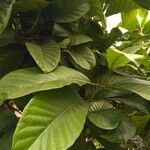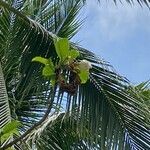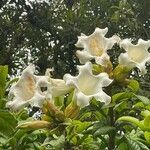A climbing shrub. It has woody stems 20 m long. The leaves are opposite. They are oval and 15-30 cm long by 7-18 cm wide. The flowers are 7.5-12.5 cm long and bell shaped. The fruit are oblong woody follicles. They contain many seeds.
Young branches and leaves rusty; leaves slightly obovate, acuminate, to 30 cm long.. Flowers white, to 15 cm long.
Stamens included; filaments ≥ 30 mm long





